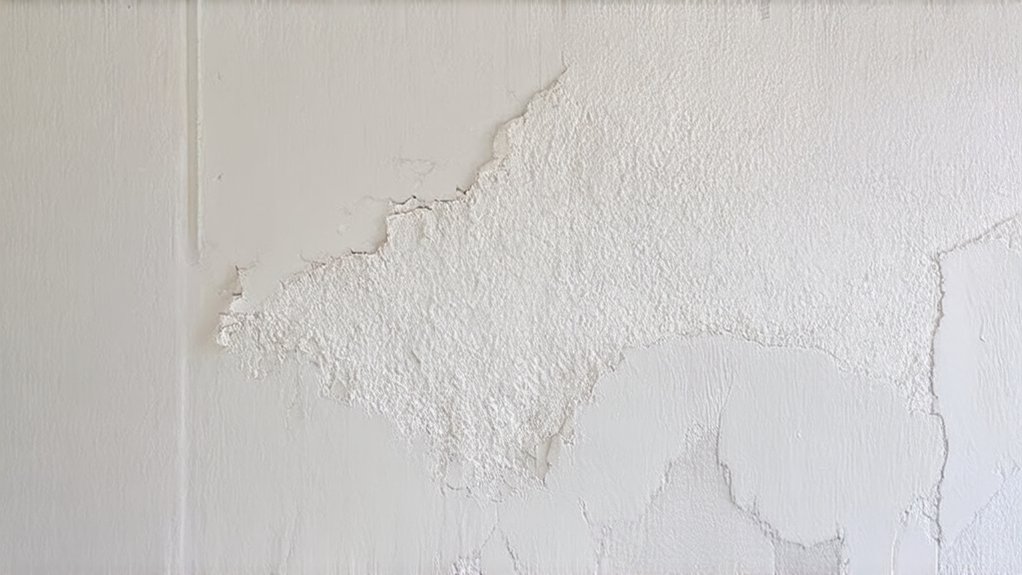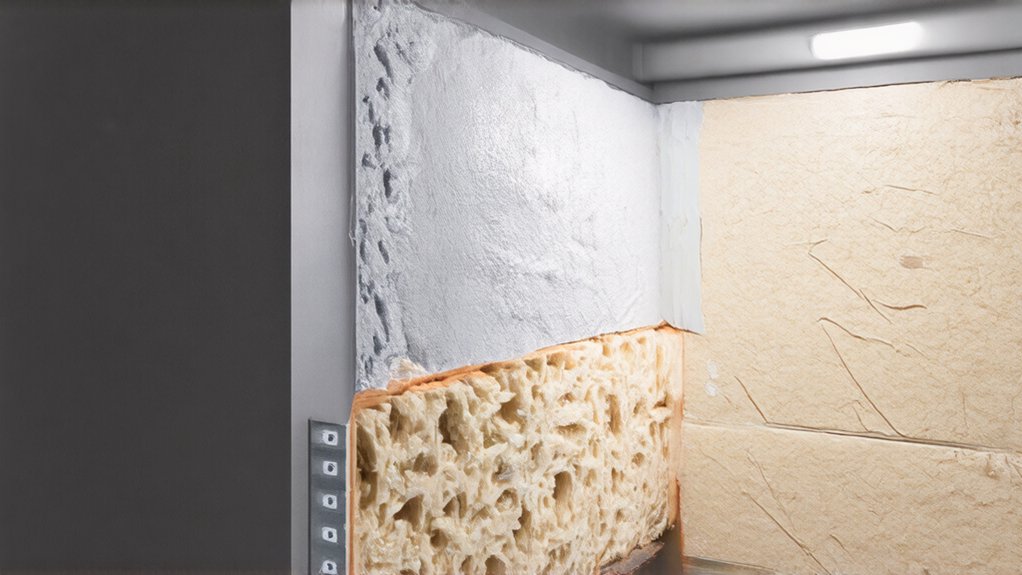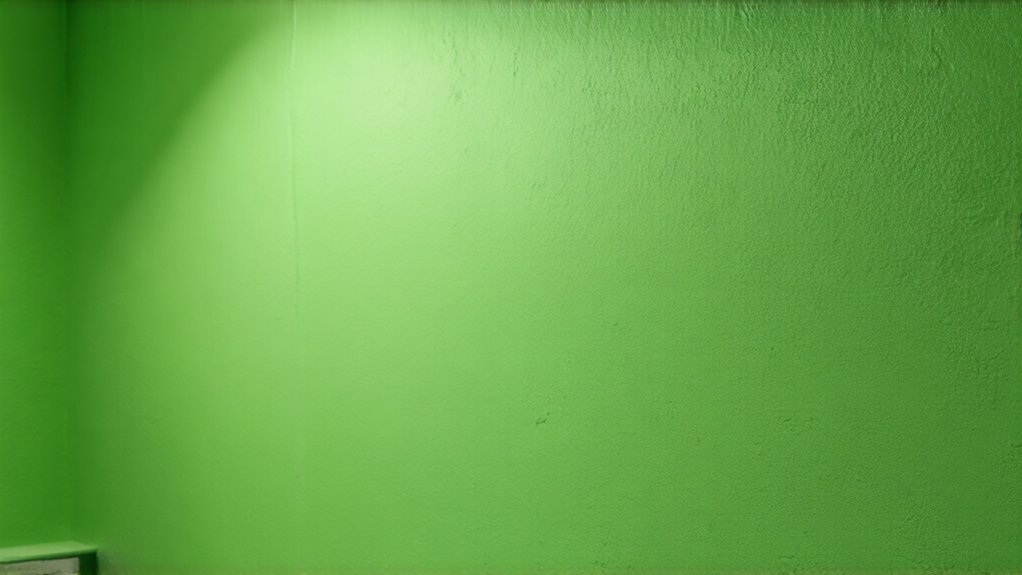To prevent paint bubbling and peeling on drywall, you'll need to manage moisture carefully. Control humidity levels between 40-50% using a dehumidifier and guarantee proper wall preparation. Clean surfaces thoroughly, repair imperfections, and apply a high-quality primer. Paint during mild temperatures, avoiding high humidity conditions. Choose the right paint sheen for your space, and use professional application techniques. Want to achieve the perfect paint finish? Keep exploring.
Understand Surface Moisture and Humidity
Before you start painting, understanding surface moisture and humidity is critical to preventing paint bubbling and peeling on your drywall. You'll want to manage humidity levels in your space to guarantee a successful paint job.
High moisture can cause serious problems, leading to unsightly bubbles and eventual paint failure. Check your room's humidity with a simple meter, aiming for 40-50% relative humidity. If levels are too high, use a dehumidifier to stop condensation formation. Professional drywall contractors in Erie, PA recommend proper moisture control to ensure a flawless paint finish.
Prepare Walls With Proper Cleaning and Repair
Preparing your walls for painting requires thorough cleaning and careful repair to guarantee a smooth, enduring finish. You'll want to start by pretreating flaking surfaces with a scraper or sandpaper, removing loose paint and creating an even base. Drywall installation experts recommend using high-density, moisture-resistant materials to prevent future paint adhesion issues. Address any structural issues like small holes or cracks by applying spackling compound and sanding them smooth. Wipe down the entire wall with a damp cloth to remove dust, dirt, and grease that could prevent paint adhesion. Let the surface dry completely before priming, ensuring your new paint job will look professional and last for years.
Choose High-Quality Primer and Paint
The foundation of a lasting paint job lies in selecting top-tier primer and paint that'll protect your walls from bubbling and peeling. You'll want to invest in high-quality products designed specifically for drywall surfaces.
When choosing paint, consider the proper paint application techniques and select a paint sheen that matches your room's functionality. Glossier finishes work well in high-traffic areas, while matte options suit low-moisture spaces.
A premium primer creates a smooth base that helps paint adhere better, reducing the risk of future wall imperfections. Your careful selection will pay off.
Control Temperature During Painting
Temperature plays a critical role in attaining a flawless paint finish on drywall, with extreme conditions potentially sabotaging your hard work. Maintaining ideal lighting conditions and consistent airflow helps prevent paint bubbling and peeling.
Key temperature considerations include:
- Avoid painting when humidity is above 85%
- Guarantee room temperature is between 50-90°F
- Wait for dry, mild weather conditions
- Keep windows closed during painting
- Allow proper drying time between coats
Your careful attention to temperature and environmental factors will help you create a professional-looking paint job that improves your living space and safeguards your walls from potential damage.
Apply Paint Using Correct Techniques
Because achieving a smooth, professional paint finish requires more than just selecting the right color, you'll want to command several critical application techniques. Apply paint in thin layers to prevent bubbling and guarantee even coverage.
Use proper painting tools like high-quality rollers and brushes that distribute paint uniformly. Work methodically from top to bottom, maintaining consistent pressure and overlapping each stroke slightly. Avoid overloading your roller or brush, which can cause drips and uneven surfaces.
Allow Adequate Drying Time Between Coats
After becoming proficient in paint application techniques, you'll want to give each coat sufficient time to dry completely. Rushing this process can lead to disastrous results.
Key considerations for drying time include:
- Patience prevents peeling and bubbling
- Proper ventilation speeds up drying
- Consistent humidity impacts paint performance
- Waiting saves time and money
- Quality results require careful attention
Ensure your room has adequate airflow by opening windows or using fans. Different paint types require varying drying times, typically ranging from 2-4 hours between coats. Check the manufacturer's instructions for specific guidance. Remember, allowing paint to dry thoroughly creates a smoother, more professional finish that'll make you proud of your hard work.
Inspect and Maintain Painted Surfaces
You'll want to stay proactive about maintaining your freshly painted walls to preserve their beauty and longevity. Regularly examine surface conditions to catch potential issues early.
Monitor wall degradation by checking for subtle signs of wear, such as tiny cracks, discoloration, or slight bubbling. Schedule periodic inspections every six months, focusing on high-traffic areas and spaces exposed to moisture.
When you spot minor imperfections, address them promptly to prevent extensive damage. Small touch-ups can save you from costly repairs and maintain your wall's professional appearance. Your diligence will protect your investment and keep your walls looking pristine.
Frequently Asked Questions
Can Old Paint Layers Cause Bubbling if Not Properly Removed?
Yes, old paint layers can absolutely cause bubbling if you don't remove them properly. You'll want to focus on thorough surface preparation and ensuring complete paint layer adhesion before applying new coats for a smooth, professional finish.
How Long Should I Wait Before Painting After Wall Repairs?
You'll want to wait at least 24 hours after wall repairs before painting. Guarantee proper drying times and adequate surface preparation by letting spackle or joint compound fully cure, creating a smooth, stable foundation for your fresh paint.
Does Sunlight Exposure Affect Paint Durability on Interior Walls?
You'll want to be careful with direct sunlight exposure, as it can cause moisture fluctuations that fade and weaken your paint's durability. We've all experienced walls that look worn, but strategic window treatments can help protect your space.
What Causes Paint to Peel in Specific Areas of a Room?
You'll often see paint peeling in areas with moisture intrusion or poor surface preparation. These spots reveal underlying issues like water damage, high humidity, or inadequate wall cleaning before painting, signaling where your walls need attention.
Are Certain Wall Materials More Prone to Paint Bubbling?
You'll find drywall with uneven surfaces or exposed to moisture intrusion are most susceptible to paint bubbling. Older walls with previous damage or high-humidity areas can create challenging conditions that make your paint more likely to bubble and peel.



